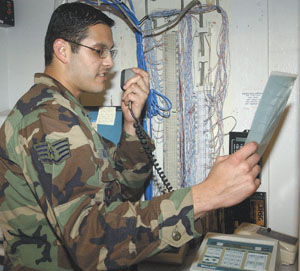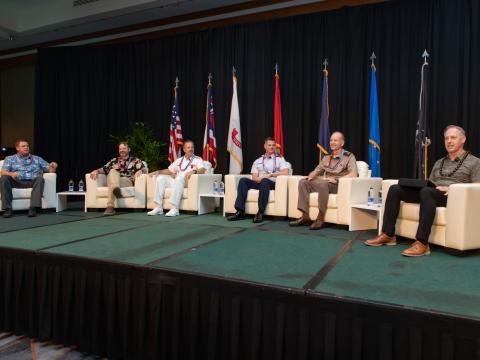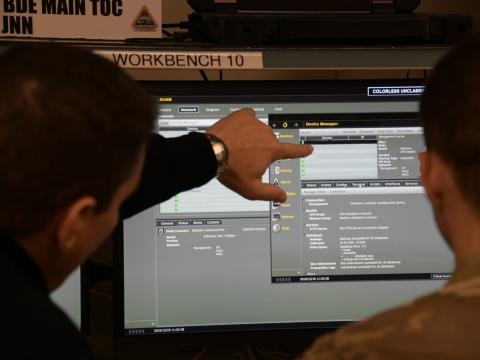Alert System Attracts Attention
Editor's Note: This is a revised version of the article that appeared in the May 2006 issue of SIGNAL.
 |
| Staff Sgt. Bob Abujen, USAF, command post senior controller, Air Education and Training Command, makes an announcement over the Giant Voice system from the Randolph Air Force Base Command Center. |
System’s visual and audio signals facilitate widespread information dissemination.
Technology is enabling base commanders and command post personnel to send out alerts in emergency situations more quickly. The new warning systems, being installed on several
To comply with U.S. Air Force Instruction 10-2501, which mandates that bases have a full-spectrum threat response installation warning system, the U.S. Air Education and Training Command (AETC), Randolph Air Force Base,
The AETC chose AtHoc IWSAlerts version 6.1, a public key infrastructure-encrypted system, as its networked alerting system. The software, developed by AtHoc Incorporated,
“The only time you’re not going to see the alert is if your program is locked,” says Senior Master Sgt. Ed Willson, USAF, IWS program manager, AETC. He adds that even when people are not at a computer at the time they receive a message, the audio component will notify personnel in the vicinity of the computer that an alert has been received.
The networked alerting system takes advantage of the time personnel spend in front of computers in a way the other IWS components, Giant Voice and telephony, cannot. Giant Voice, an installationwide public address system, can reach only those people who are outdoors when they receive the message. People who go outside to hear an alarm are often being instructed to remain inside the building, as in the case of an approaching tornado. Telephony is slow and reaches only a few personnel directly, Sgt. Willson says. “When we put all three together, we get the complement of being able to alert several thousand folks at once,” he adds.
At Vance Air Force Base in
In addition to a greater coverage area, the three components give installation commanders and command post personnel flexibility in alert messaging. Installation leadership can configure the three components for each emergency. After activating Giant Voice, the command post can send networked alerting system messages simultaneously. The command also can choose to use the features separately.
By using IWSAlerts software, command post personnel can customize not only the medium of the message but also the recipients within the networked alerting system medium. With a single click in the software, messages can be sent to all devices connected to the installation network or to smaller, predetermined groups such as a hazardous substance response team.
Unlike contacting personnel through e-mail, which fails to reach people who are not sitting at a computer or those who do not check their e-mail regularly, the IWSAlerts warnings attract attention through pop-up windows and audio alerts so they reach everyone connected to the installation network. According to Guy Miasnik, chief executive officer, AtHoc, the command post can reach all personnel on base within a minute.
“It’s a value from an emergency operational response perspective,” Miasnik says.
Another advantage of IWSAlerts is its ability to provide recipients with detailed instructions and actionable information. For instance, if an incident occurs on an installation where a mission-oriented position posture (MOPP) has been implemented, personnel could click on the message and receive instructions on equipment and action necessary for the particular MOPP level. In another scenario, where personnel need to congregate at a predetermined location, clicking on the message will call up an installation map with the meeting area highlighted. “You can’t miss it,” Miasnik says. “It gets to everyone on time with a very clear message of what to do.”
Miasnik says the program could be used at the command level to alert everyone in a command about an emergency, but at the AETC, Sgt. Willson notes, the emergency notifications will generally be an installation-level decision, and each wing commander is responsible for the forces below him. “IWS saves people and resources,” Sgt. Willson says. He explains that those types of protection decisions will be made locally, not by the command.
The IWSAlerts software contains default instructions founded on an individual base’s procedures for various emergencies. However, the alerts can be customized before being sent, allowing the command post to send specific or varying instructions depending on the situation. The customization feature improves the ability of command and control personnel to disseminate necessary information.
The combination of alerting more people faster and with more detailed information is an improvement over older approaches and a capability that is needed by base commanders. According to Sgt. Willson, the bottom line for the AETC was being able to meet the requirement to give the commander a chance to notify his or her people or resources in an effective manner. Though IWSAlerts underwent testing in the pilot phase, the technology has not yet been employed in a real-life scenario, he adds.
Within the AETC, the IWSAlerts is deployed in
Other Air Force commands also are looking at IWSAlerts as a way to integrate the networked alerting system into their installations. The software is fully deployed at Vandenberg Air Force Base,
At Vandenberg, IWSAlerts is not connected to the Giant Voice or telephony system, nor does it send alerts to communications devices other than computers. However, users and officials such as Lt. Col. Daniel Birrenkott, USAF, commander of the 30th Space Communications Squadron at Vandenberg note the importance of having the audio and visual alert. “The big difference between getting an e-mail and IWSAlerts is you have to be logged in and using e-mail at the time,” Col. Birrenkott says. “The significant advantage is an alert is not buried in an inbox.” He adds that the system gets the word out quickly and “if you’re near a computer, you have to respond to it because it continues to give out audio alerts otherwise.”
Vandenberg has used the program to disseminate weather warnings, and the commander also uses the software to alert personnel when an alcohol-related incident occurs or to caution personnel about alcohol use at certain times of the year, for example, over a holiday weekend. Vandenberg personnel customize each alcohol-related announcement because the system does not come prescripted with those types of warnings.
Col. Birrenkott expects weather warnings to be the most frequent messages dispersed during non-exercise conditions, and they have been so far. During exercises, he expects force protection condition updates to be sent out most frequently.
IWSAlerts fits into Vandenberg’s overall warning system, augmenting other components such as the land mobile radio network for command and control operations centers and the telephone system. According to Col. Birrenkott, each element in the system has an important function. For example, using a calling tree allows for personal, validated responses to each message. The alerting system can reach everyone at a computer quickly, unlike Giant Voice or telephony. By having all the components of the message system operating, base officials increase their ability to contact personnel in an emergency.
In addition to alerting personnel to emergency situations, the colonel sees the system as a method to inform people of base incidents that affect normal routines. For example, if an automobile accident occurs at one of the gates, personnel could be advised to avoid the gate via the IWSAlerts system. “I wouldn’t see IWSAlerts as a way to call the police,” he says. “What you’re doing is telling everyone else so they can stay out of the way.”
Col. Birrenkott says that because the software could be used as a base message system for nonemergency situations such as base personnel gatherings, officials at Vandenberg are taking steps to prevent that from happening. “We’re not going to allow it to be used for that,” he says. “It has to fit within the definition of command and control.”
In other areas of the Air Force, Pacific Air Forces is running a pilot of the program, and other military branches are interested, too. For example, the commander for Navy installations conducted a study of the most cost-effective ways to protect facilities. Having an area-wide alert/notification system on base received the second highest cost-to-benefit ratio after implementing a decision-making process. According to Miasnik, his company is working with the U.S. Navy to install the system at Naval Station Norfolk in Virginia, where a pilot program already has taken place, and then to expand the system to other bases.
In the U.S. Army, the system is deployed at
The software can be up and running in three to five days, Miasnik notes. A team from his company installs the system on-site, trains command post staff and information technology personnel and customizes for any specific base procedures. “Literally, within a week, you have it,” Miasnik says.
Web Resources
AtHoc Incorporated: www.athoc.com
Air Education and Training Command: www.aetc.randolph.af.mil
Vance Air Force Base: www.vance.af.mil
Vandenberg Air Force Base: www.vandenberg.af.mil

